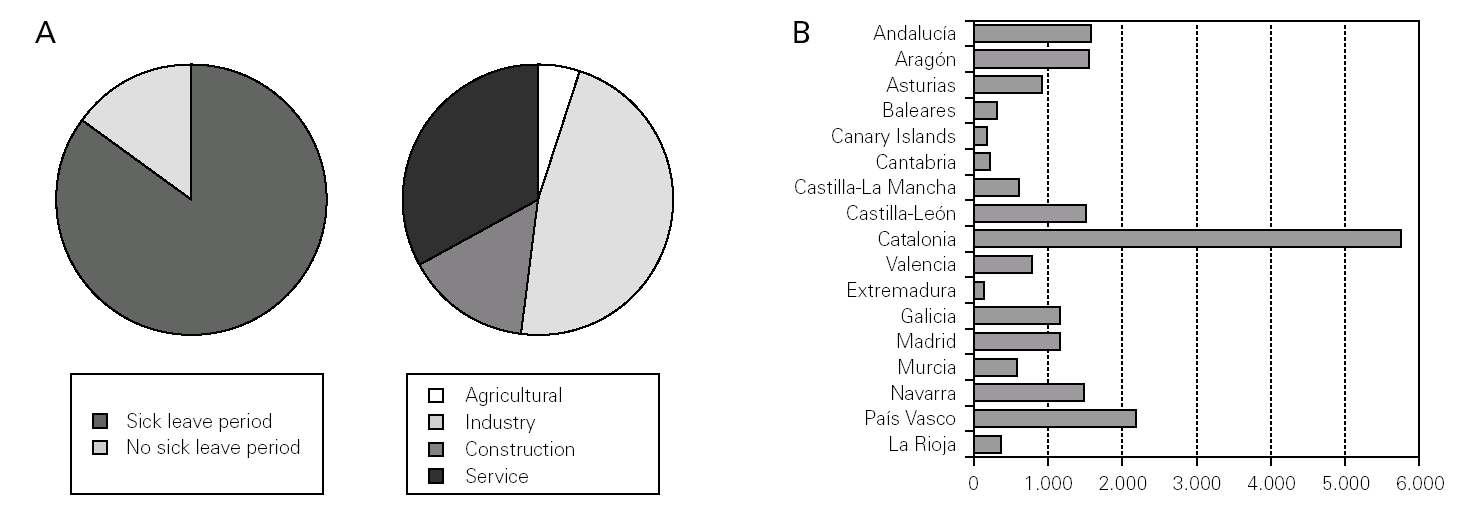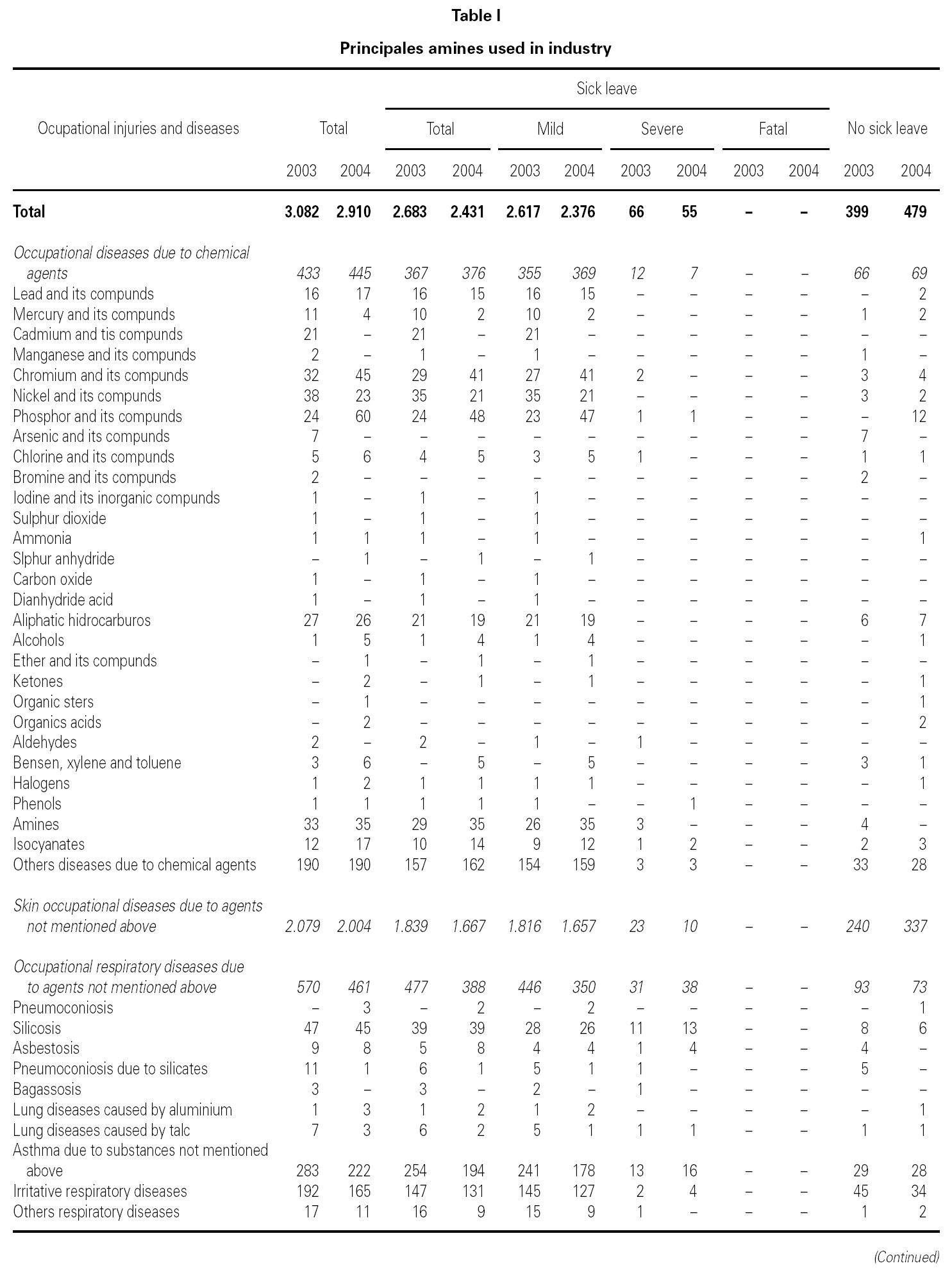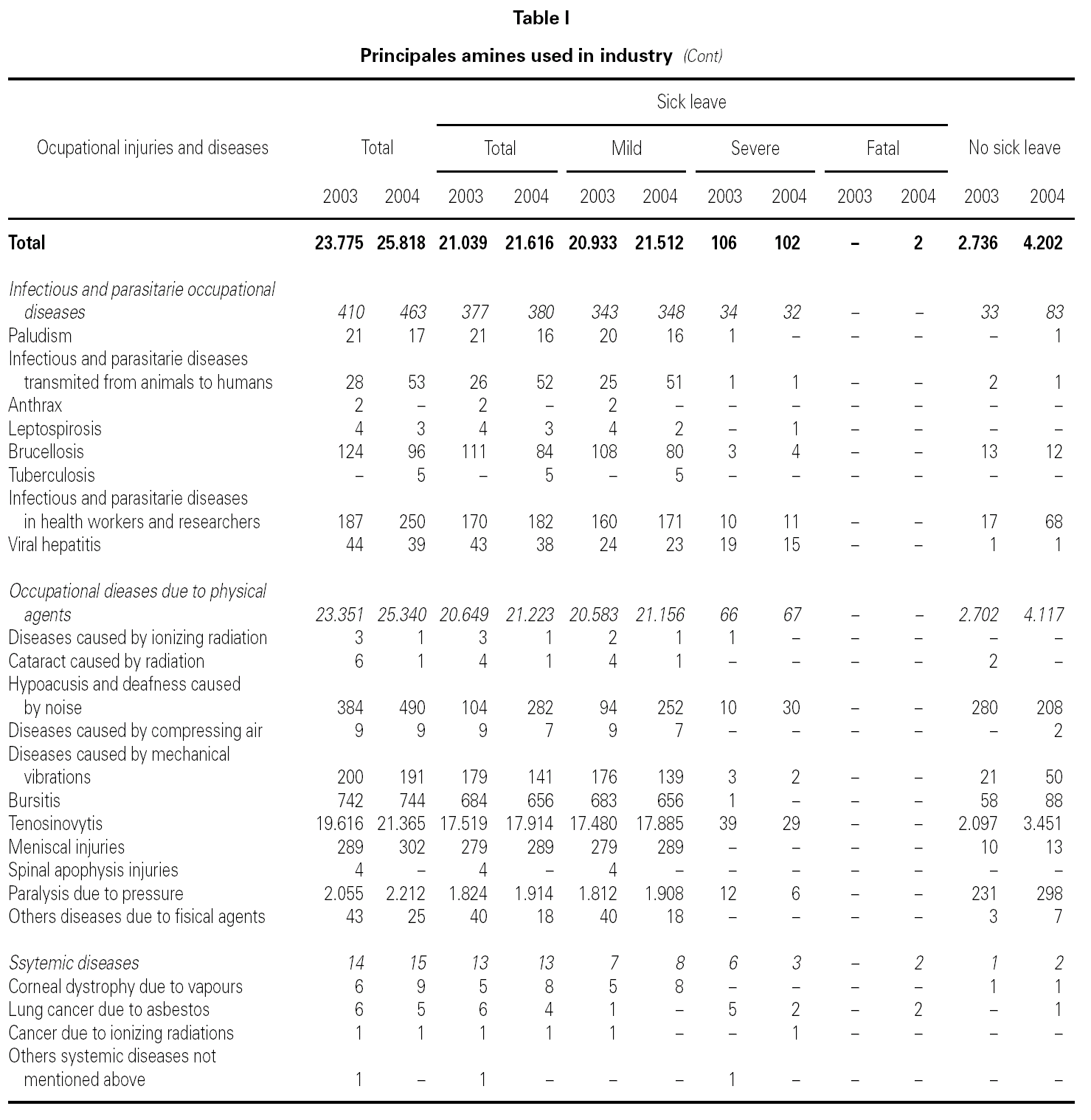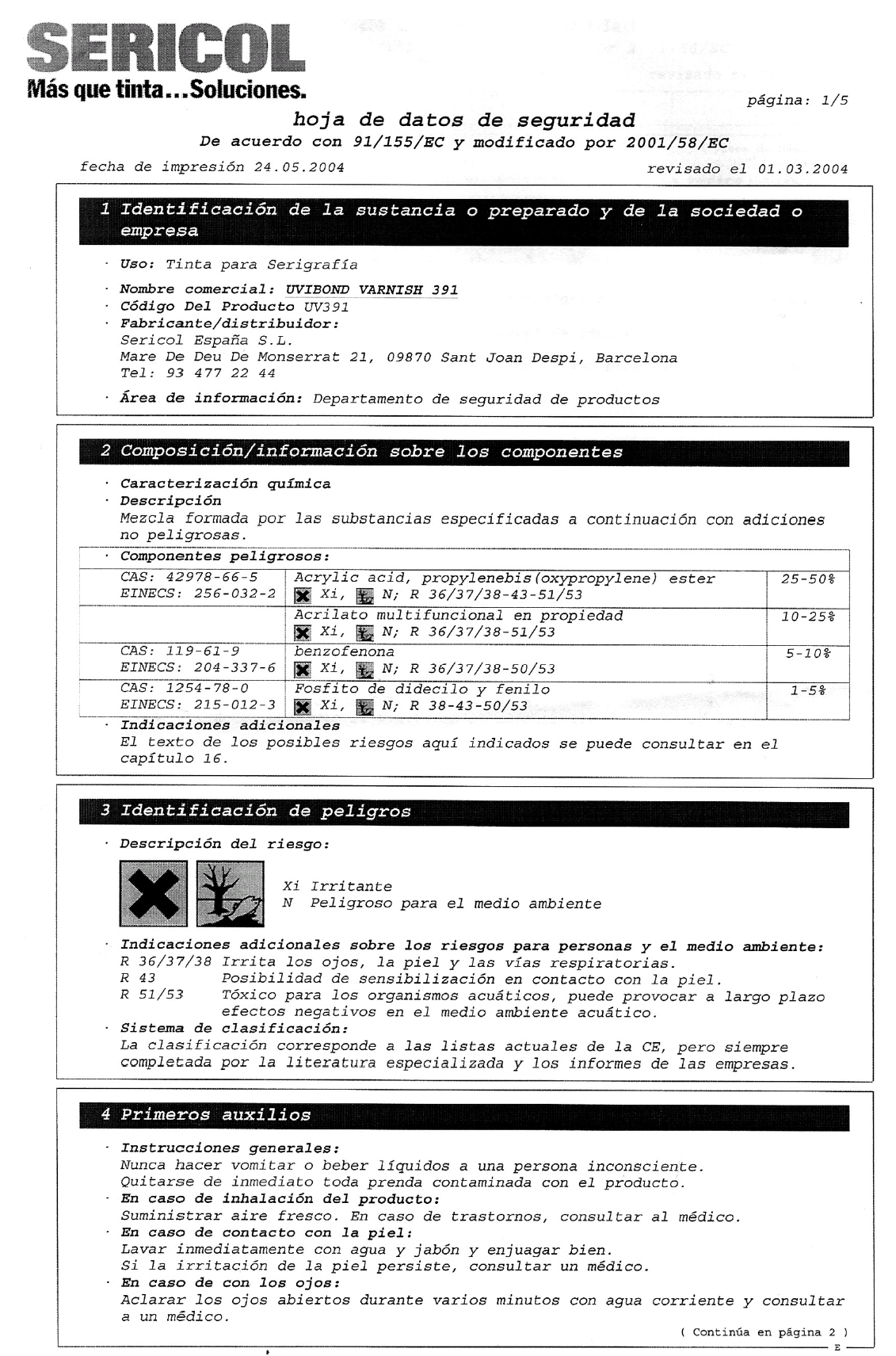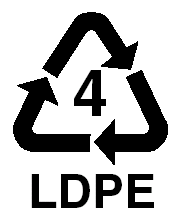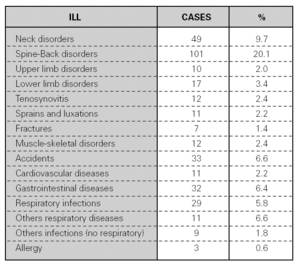DEFINITION OF PROFESSIONAL ASTHMA
Occupational or professional asthma is defined as adult asthma, i.e., an inflammatory respiratory disease characterized by the existence of variable airflow limitation or bronchial hyper-reactivity secondary to conditions and causes associated with a given occupational or working environment not with stimuli found outside the workplace 1.
Non-asthmatic eosinophilic bronchitis (i.e., the presence of eosinophilic bronchial inflammation without bronchial hyper-reactivity) may have an occupational origin 2-6. Establishing the diagnosis of a disease is always of fundamental importance for the patient. In the case of professional asthma, a correct diagnosis is even more important, since it has not only clinical but also legal, economical and social consequences. The etiological diagnosis of professional asthma is a critical consideration, due to the aforementioned reasons. Whenever possible, a cause-effect relationship must be established between the patient asthma symptoms and professional or occupational exposure. This is essential in order to document the disease in legal courts and in other institutions where the affected patients may seek a declaration of occupational disability and the pertinent economical compensations.
In 1993, Bernstein et al 1 defined professional asthma as "a disease characterized by the existence of variable airflow limitation and/or bronchial hyper-reactivity secondary to conditions and causes associated with a given occupational or working environment, not with stimuli found outside the workplace".
The relationship between occupational activities and the appearance of illnesses began to be documented in the XVIII and XIX centuries with the advent of the industrial revolution. As with any major technological advance, victims soon began to be registered. People fell ill and died because of their working activities. In the XVIII and XIX centuries, however, these problems received very little attention.
Two centuries later, legislation in all industrialized countries protects the rights of workers. Nevertheless, a number of things remain to be done in the concrete case of asthma as a professional disease.
DEFINITION
Spanish Social Security legislation defines professional disease as "an illness contracted as a result of remunerated work done for others (work done on the worker's own account, i.e., on an autonomous basis, being included in this definition on occasion of the last pertinent legal reform), in the context of the activities detailed in the table contemplated by the law and produced by action of the elements or substances specifically related in the mentioned table to each professional disease". This list dates from the year 1978, and at present up to 320 substances capable of causing professional asthma have been identified.
In the period between January and September 2005, a total of 21,858 professional diseases were documented (fig. 1). Of these, 10,642 corresponded to the industrial sector. In the year 2004, a total of 24,047 professional diseases were registered, of which 2910 were caused by chemical agents and 461 resulted from the inhalation of substances not included in the section commented above (fig. 2). In the period between January and November 2005, a total of 841,135 labor accidents resulting in sick leave were recorded. However, in the last National Survey of Working Conditions, involving 3800 interviewed workers (fig. 2), non-specified respiratory diseases or allergies accounted for only 7.2 % of the total the most common reason for seeking medical help being back pain (30 %).
Figure 1.--A) Occupational diseases by severity and sector (January-September 2005). Source: Spanish Ministry of Labor and Social Affairs. B) Occupational diseases by spanish regions (January-September 2006). Source: Spanish Ministry of Labor and Social Affairs.
Figure 2.--Work-related illness. Source: Spanish Ministry of Labor and Social Affairs.
REASONS FOR MEDICAL CONSULTATION IN THE WORKPLACE
These data suggest that the diagnosed cases and registered situations of disability due to professional asthma are probably only the tip of the iceberg. Adequate training of all human resources found between the workers and their workplaces company physicians, business executives, the workers themselves and the creation of official reference centers for the specific diagnosis of such diseases should contribute to improve and increase the diagnosis of these problems.
CLASSIFICATION OF OCCUPATIONAL ASTHMA
Work-related asthma is divided into two major groups:
1. Occupational or professional asthma as such, i.e., caused by specific substances found in the workplace of the patient.
2. Pre-existing asthma exacerbated in the workplace.
In addition, eosinophilic bronchitis without asthma may have an occupational origin 2-6.
Two groups of asthma are considered, depending on the pathogenic mechanism involved in the development of professional asthma:
Inmunologic asthma
In this form of the disease there is a latency period between occupational exposure and the appearance of asthma. This category comprises all cases in which there is a demonstrable or probable immune mechanism (mediated or not by IgE antibodies), and includes most high molecular weight agents (> 1000 Da) and some low molecular weight agents (< 1000 Da).
Non-Inmunologic asthma
No latency period is observed in this form of the disease, which is represented by reactive airways dysfunction syndrome (RADS) or, more globally, by irritant-induced asthma.
DIAGNOSIS OF PROFESSIONAL ASTHMA IN THE INDUSTRIAL SETTING
In the year 1975, Jack Pepys wrote: "One of the principal obligations in asthma, as in any other disease, is to establish a precise diagnosis. This is particularly important in the case of allergic disorders, where avoidance of the causal agent determines the course of the disease" 7. Guided compilation of the case history and the measurement of nonspecific bronchial hyper-reactivity and airway inflammation (induced sputum study and measurement of exhaled nitric oxide, NO), together with more routine tests, are presently essential considerations in the diagnostic approach to occupational asthma. Identification of the etiology of a case of professional asthma may prove quite straightforward if the causal agent has already been reported elsewhere in the literature, such as for example in painters in the automobile industry sensitized to isocyanates. However, in the industrial setting, this is almost never the case, and investigation of the causal agent may become like searching for a needle in a haystack. Cooperation among company physicians and the labor medical care associations is always desirable to this effect, particularly on taking into account that the expenses derived from the study of any professional disease (including asthma) are covered by such medical care associations in compliance with applicable Spanish legislation.
The study of the material safety data sheets or summaries of product characteristics of the elements manipulated by the patient in the industrial setting is a first step to guide the study. In most cases the causal agents are low molecular weight substances. The mentioned material safety data sheets may cite components already documented in the literature as being responsible for allergic manifestations (respiratory or otherwise) or respiratory problems in general (pneumonitis, pneumoconiosis, etc.) alerting us to their possible implication in the asthma of the patient. In other cases this is not so, however. In addition to specifying the physico-chemical characteristics of the product, the formulations, storage conditions, protective measures and safety coding, the material safety data sheets indicate the maximum permisible exposure values, where available (table I). In general, two threshold limit values.
(TLVs) are defined for each substance: the TWA (time-weighted average) and the STEL (short-term exposure limit). The TWA is defined as the mean 8-hour-weighted concentration that must not be exceeded in any period of 8 hours for 40-week working weeks. The STEL is in turn defined as mean concentration for periods of 15 minutes (provided no other time period is specified) that must not be exceeded at any time during the working day.
These are toxicological thresholds, since the sensitization threshold values are always comparatively lower. Nevertheless, they must be known in order to design specific bronchial provocation tests or to conduct environmental studies or provocation tests in the workplace of the patient. As an example, in our routine clinical practice we have had cases of patients with suspected isocyanate-induced asthma in which the corresponding provocation tests proved negative. In these cases it was necessary to visit the workplace of the patient, where isocyanates measured in the working environment were found to far exceed the corresponding TLVs.
The assay of specific IgE may be of help in relation to certain low molecular weight substances (acid anhydrides, platinum salts, reactive dyes, etc.) and in application to most high molecular weight substances (cereal flours, latex, etc.). However, this is not possible in the case of most industrial low molecular weight agents, either because no underlying IgE-mediated immune mechanism is known for these substances, or because they constitute novel chemical agents. It is therefore necessary to conduct specific bronchial provocation tests in these situations to determine the substance responsible for the professional asthma. The purpose of specific bronchial provocation is to evaluate bronchial reactivity to the agent causing professional asthma in each concrete case. Thus, the test assesses the response of the specific organ the airways to aerosols, powders, vapors or fumes to which the patient is exposed in the workplace.
The use of new chemical substances is increasing in the industrial setting, and this is in turn associated with an increased possibility of new sensitizations. Specific bronchial provocation is particularly indicated in the case of such new substances with still unknown respiratory sensitization potentials (fig. 3).
Figure 3.
Whenever possible, exposure must attempt to reproduce the working environment of the patient as precisely as possible. In addition to the diagnostic objectives of the provocation test, the latter is also used to investigate the pathogenic mechanisms of already known or novel causal agents.
The choice of one or other specific bronchial provocation method is particularly dependent upon the type of agent involved. The options range from the most common technique, involving provocation with a nebulizer under tidal volume conditions, to the most sophisticated dynamic exposure chambers.
A description is provided below of the different types of professional asthma caused by low molecular weight industrial agents: chrome and nickel salts, cutting oils, plastic derivatives and acrylates.
ASTHMA DUE TO CHROME AND NICKEL SALTS
The capacity of metals to cause disease, including respiratory illnesses, has been known for centuries 8. The relative infrequency of metal-induced respiratory symptoms compared with cutaneous manifestations may be attributed in part to the fact that many cases of asthma caused by metals are not diagnosed. Most occupational respiratory disorders produced by metals are considered benign. It has been estimated that about ten million workers may be affected by such disorders 9.
Exposure to metals or metalloids in pure form (i.e., fully non-oxidized) is very rare. Exposure to metal salts is much more common. Metals, and particularly transition metals, can form complexes with different ligands such as ammonium, carbon monoxide, organic nitrogen or sulfur.
Asthma caused by metals is a recently described condition, as a result of which no specific classification has yet been developed for this type of professional asthma. Consequently, asthma due to metals is usually classified according to the causal metallic agent: transition metals (vanadium, chrome, nickel, etc.), noble metals (palladium platinum, etc.) and heavy metals (tungsten, cobalt, etc.).
Bernstein et al 1, in the treatise Asthma in the workplace, proposed a classification for the agents causing asthma, according to their location in the periodic table of elements 10:
First series of transition elements: vanadium, chrome, cobalt, nickel and zinc.
Second series of transition metals: ruthenium, rhodium, palladium and cadmium.
Third series of transition elements: iridium and platinum.
Group III metals: aluminum.
Indeterminate metals due to alterations or contaminants present in manufactured products.
Most cases of professional asthma caused by metals are associated with transition metals. In the present study we will focus on professional asthma caused by chrome and nickel salts. However, the absolute number of cases of professional asthma due to exposure to platinum and aluminum greatly exceeds the number of cases of asthma attributable to other metals 11-13.
Occupational asthma caused by chrome and nickel salts seems to be rare, though a number of cases have been reported in recent years 14-20. In contrast, skin disorders, particularly allergic contact dermatitis caused by these metals and particular by chrome are much more frequent (accounting for 10 % of all positive epicutaneous tests among Caucasians) 21. The professions and activities related to chrome and nickel exposure are varied: electrolytic plants, cement factories, and construction and welding processes in general. Moreover, in most of these activities the salts of both metals are usually manipulated in combination.
Contact dermatitis attributable to these metals may precede the appearance of respiratory symptoms 16, though this is not always the case 17,19-20.
The first case of asthma induced by chrome salts was published in the year 1869 22. The two largest series to date are those documented by Bright et al 18 and Fernández-Nieto et al 20, with 7 and 4 workers, respectively, corresponding to different industries involving the use of chrome and nickel salts.
Diagnosis
The cases published present asthma after provocation under conditions of tidal volume with chrome and nickel salts at a concentration of between 1-10 mg/ml. If the concentrations are too high, irritative responses may result. In any case, the great variety of asthmatic responses obtained after provocation in both published series 18,20, together with the nonspecific bronchial hyper-reactivity changes observed and the variations in cell count in the induced sputum samples, rule out the possibility of a simple irritant effect 14-16,19,20.
The usefulness of epicutaneous testing and of the determinations of specific IgE as diagnostic tools in professional asthma induced by metal salts remains unclear.
In an epidemiological study involving workers in the electrolytic industry 18, the size of the papule elicited in these patients was unrelated to the result of the bronchial provocation test. Positive epicutaneous tests (> 2 mm) were observed in 10 % of the exposed workers with symptoms suggestive of professional asthma, in 15 % of the exposed workers that suffered rhinitis, in 11 % of the exposed workers without symptoms, and in 2 % of the non-exposed controls. In the series published by Fernández-Nieto et al 20, a 2-mm papule was recorded in two of the workers. The tested controls proved negative.
Novey et al 15 demonstrated specific IgE antibodies against chrome and nickel conjugates in an electrolytic industrial worker with professional asthma. Malo et al in turn reported the case of a worker in an electrolysis plant presenting professional asthma with a positive bronchial provocation test in response to nickel, and negative epicutaneous tests and RAST findings. Dolovich et al suggested that antigenic determination (for nickel) is dependent upon binding of this metal to human albumin at the primary binding site for copper. Fernández-Nieto et al in turn demonstrated specific IgE against chrome and nickel via enzyme-linked-immunosorbent assay (ELISA) in one of their four published cases 20.
Pathogenesis
The pathogenesis of professional asthma caused by these salts is little known. As has already been commented, in some but not all cases, allergic contact dermatitis may precede asthma. An approach to the underlying pathogenesis may therefore be made on the basis of contact dermatitis.
Because of their small size, metal ions are incomplete antigens that must bind to endogenous peptides to become truly antigenic. They associate in a triple-molecular complex composed of the class II major histocompatibility complex (MHC II), the binding peptide and the corresponding T lymphocyte receptor to induce a T cell-specific response. It has been shown that T lymphocyte clones specifically targeted to metal ions recognize haptens in the context of MHC II molecules. No association has been demonstrated among certain human leukocyte antigen (HLA) haplotypes in subjects sensitized to nickel, chrome and cobalt 23. However, certain T lymphocytes expressing the T cell receptor with the different V-beta chains seem to be correlated to the severity of contact dermatitis induced by nickel.
To date, little is known of the structure of the antigenic epitopes created after epicutaneous exposure to metal salts. Moulon et al 24 have investigated the processing involved in T lymphocyte recognition of nickel, and hapten recognition has been shown to be independent of processing by the antigen-present cells (APCs) in most of the human T lymphocyte clones studied.
Cross-reactivity
Concomitant sensitization to different metals is a contrasted clinical observation. an obvious question that may be raised is whether this clinical phenomenon is due to the existence of some type of cross-reactivity among several metal species. In this context, Moulon et al 24 exposed a group of nickel specific T lymphocyte clones from four patients allergic to metals and examined their cross-reactivity with palladium, cobalt, copper, chrome, zinc and platinum. The authors detected cross-reactivity among nickel, copper and palladium explaining the phenomenon in terms of the structural similarity of these species. Since no cross-reactivity was observed between nickel and cobalt, the authors concluded that in vivo reactivity to these metals is the result of concomitant sensitization.
Sastre et al 19 demonstrated the existence of cross-reactivity between chrome and nickel in an electrolytic industrial worker.
PROFESSIONAL ASTHMA DUE TO CUTTING OILS OR MACHINING FLUIDS
These are products used for the manipulation (cutting) of metal pieces, in order to reduce cutting tool friction heat, and thus avoid deterioration while improving the finish of the manipulated elements. mixed with water, there are a number of types of such products.
Types
1. Oily fluids (cutting oils).
2. Aqueous fluids: oils or non-oils plus other elements (emulsifiers, amines, etc.), which are in turn classified as:
Emulsions
Synthetic formulations
Semisynthetic formulations
Neosynthetic formulations
All of these products may also contain additives such as bactericidal products, deodorants, dyes, soaps, fatty acids, etc., or contaminants such as traces of the machined elements (chrome, nickel etc.).
Many studies have described cutaneous disorders, particularly contact dermatitis, produced by these substances 25-29. In contrast, in only a few cases has a causal relationship been established with the appearance of professional respiratory pathology, pneumonitis 30 or asthma 31-33.
Amines and alcalonamines have been the cutting fluid components related with the documented cases of professional asthma due to these substances 34,35.
Amines are nitrogen compounds derived from ammonium (NH3), in which one or more hydrogen atoms are replaced by hydrocarbon groups. They are classified according to the number of replaced hydrogen atoms as follows:
Primary amines: Substitution of an H atom by an alkyl or aryl group. (Example: NH2CH2OH [2-aminoethanol].)
Secondary amines: Substitution of two H atoms by alkyl or aryl groups. (Example: Piperidine.)
Tertiary amines: Substitution of three H atoms by alkyl or aryl groups (Example: Triethylamine.)
Quaternary amines: Substitution of four H atoms by alkyl or aryl groups (Example: Benzalkonium chloride.)
Classification can also be based on the molecule substituting the hydrogen atom:
Aromatic amines: when the H atom is replaced by a benzene ring.
Aliphatic amines.
Occupational asthma attributable to amines is infrequent. According to the review published by Hagmar et al 37, approximately 40 amines have been identified as being able to cause professional asthma. These products are used in a broad range of industrial sectors. Recently, Quirce et al 38 published a case of professional asthma due to piperazine citrate, in a female worker in the chemical industry demonstrated via specific provocation using a powdered substance inhalation chamber.
As in the majority of substances of low molecular weights, the underlying pathogenic mechanism is not clear. In some cases immediate skin reactivity has been shown. Cross-reactivity among such substances is questionable (table I).
Alcalonamines are ammonium derivatives in which 1, 2 or 3 hydrogen atoms are replaced by an alcohol group (-OH). These products are used in the pharmaceutical and chemical industries as emulsifiers, antioxidants, corrosion inhibitors, solubilizing agents and as intermediates in the manufacture of cosmetics, soaps and detergents. Their use has been related with the appearance of dermatitis (both irritative and contact dermatitis). There have been very few published cases of occupational asthma due to mono-, di- and triethanolamine. In 1994, Savonius et al 34 published two cases of professional asthma in two metal industry workers, caused by triethanolamine contained in cutting fluid.
In 1998, Piriipari et al 35 described a case of professional asthma in a metal worker attributed to diethanolamine contained in cutting fluid.
On the other hand, 2-aminoethanol, also known as ethanolamine, 2-hydroxyethylamine or cholamine, has been identified as the causal agent in two cases of professional pathology: asthma in a worker following exposure to detergents 34, and a case of contact dermatitis in a metal worker involving exposure to cutting fluid 36.
The TLV-TWA of 2-aminoethanol is 3 ppm (7.5 mg/ m 3), while the TLV-STEL is 6 ppm (15 mg/m 3).
ASTHMA DUE TO POLYVINYL CHLORIDE (PVC) AND POLYETHYLENE
Polyvinyl chloride or PVC was discovered in 1830 by Victor Regnault. In 1912, Fritz Klatte established the principles for its industrial manufacture. Large scale production began in 1938, when its multiple potential industrial applications were established. PVC is obtained by the polymerization of vinyl chloride, which is in turn produced from chlorine and ethylene. In Europe, the PVC industry employs over 542,000 people. In Spain there are over 1750 PVC-transforming companies. The objects manufactured with this material are identified by the coding system of the United States SPI (Society of the Plastics Industry), by means of the following symbol:
PVC is the second most common plastic material worldwide, after polyethylene. There are basically two types of polyethylene:
High density polyethylene (HDPE), comprising an unbranched linear chain. It is used in construction and also in the manufacture of prostheses. Objects made of HDPE are identified by the following symbol at their upper or lower portion:
Low density polyethylene (LDPE), comprising a branched chain structure. This product is widely used in the packaging industry, for cable sheathing and in the manufacture of tubing. Objects made of LDPE are identified by the following symbol:
The thermal degradation of polyethylene and PVC has been reported as a cause of professional asthma since the sixties, in the context of so-called "meat wrapper's asthma" or, as it is now called, "food wrapper's asthma" 39-41. In 1973, Sokol et al 39 reported three women with symptoms of asthma after heating PVC. Johnston and Anderson 40 in turn described the symptoms of 15 workers in a meat packing factory. Posteriorly, the products resulting from such thermal degradation were identified, along with traces of anhydrous phthalic acid (among other substances), though none of the exposed workers presented specific IgE antibodies targeted to this chemical agent 42. In 1976, Andrasch et al 43 used provocation testing to reproduce the symptoms of professional asthma in plastic container industrial workers. Unheated PVC dust is also able to cause professional asthma 44. In the year 2003, the Spanish group led by Muñoz et al 45 published a case of professional asthma, confirmed by specific provocation testing, in a women working in the fish wrapping industry.
As has been commented, polyethylene has been described as a cause of professional asthma in packaging workers 46, and has also been associated with other industrial applications such as electric cabling 47, and the paint industry 48.
In the case of patients with suspected professional asthma due to PVC or polyethylene, as in the case of other low molecular weight agents, it is not easy to develop a specific bronchial provocation test. As a result, controlled exposure in the workplace is carried out. This was the case of a patient recently seen by our own group, who worked in a polyethylene plastic container factory. About six hours after controlled exposure lasting 60 minutes, a late asthmatic response was observed, with a reduction in maximum forced expiratory volume in one minute (FEV1) of 20 % with respect to baseline, and the appearance of induced sputum eosinophilia 24 hours after provocation.
PROFESSIONAL ASTHMA CAUSED BY ACRYLATES
Since Kopp et al 49 described the first case of occupational asthma due to acrylates (in this case it is more appropriate to use the term "occupational" rather than "professional", since the affected patient used glue to assemble models), there have been many reports likewise documented through specific bronchial provocation tests 50 and, in some cases via the measurement of inflammation in induced sputum samples 51. Acrylates are the fundamental components of the very potent glues used in orthopedics and in dental mechanics, esthetics, and the automobile industry, and in recent years they have been included in other uses as potential causes of professional asthma. In this context, a case of professional asthma has been documented in a worker due to the methacrylate contained in photocopying toner 52, and another case has been recorded in a graphic arts worker produced by the printing varnish applied to paper containing acrylates 53. In this latter case controlled exposure to the varnish was carried out in a dynamic exposure chamber.
PROFESSIONAL ASTHMA DUE TO OTHER LOW MOLECULAR WEIGHT SUBSTANCES
Fernández-Nieto et al 54 described the case of a worker in the automobile industry with professional asthma caused by styrene a low molecular weight substance. Isocyanates are commonly used in the automobile industry (in paints, solvents, etc.), though the worker was diagnosed with professional asthma by another substance called styrene. In this case the condition was demonstrated by specific exposure testing in a dynamic exposure chamber.
Styrene is a volatile monomer used in the production of polymers, copolymers and reinforced plastics. It is a transparent, colorless liquid obtained from petroleum and natural gas. Polystyrene is the end product of styrene polymerization, and is used to manufacture resins, putties and plastics contained in thousands of products thanks to its flexibility, hardness and low weight. The TLV-TWA is 50 ppm (213 mg/m 3), while the TLV-STEL is 100 ppm (426 mg/m 3). Objects made of styrene are identified by the following symbol:
CONCLUSIONS
The products used in industry in general are not easy to group into list format, due to the permanent renewal and substitution experienced these materials. It is likewise difficult to relate a given product to a specific industrial activity, since change here is also constant. It is therefore necessary to establish a clear causal relationship with the product by means of specific provocation tests. In this way it will be possible to avoid including certain components in industrial product manufacturing practices, and thus contribute to reduce the risk of new sensitizations.
Correspondence:
M. Fernández-Nieto, MD
Allergy Department. Fundación Jiménez Díaz
Avda. Reyes Católicos, 2. 28040 Madrid. Spain
E-mail: mmfernandez@fjd.es
Coordinator of the section: Dra. M.ªD. Ibáñez Sendin




